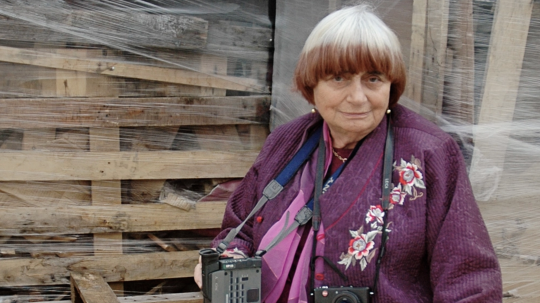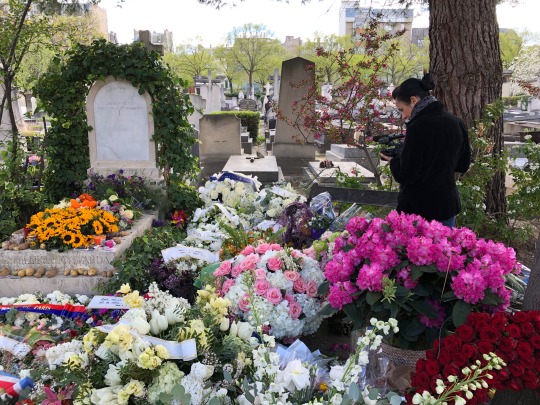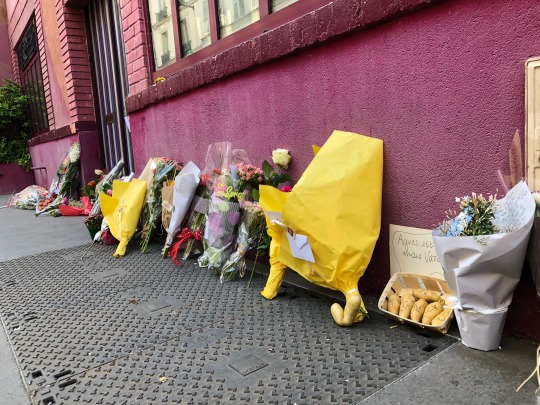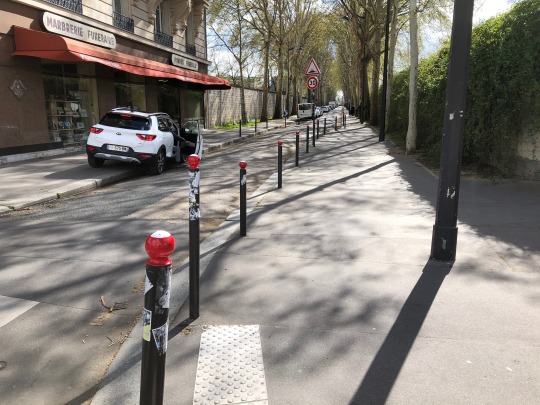Paris sans Agnès
By Yasmina Tawil

It was morning in Paris when news of Agnès Varda’s death reached the world. On a hunch, I left the apartment I shared with my girlfriend in the city’s 5th arrondissement and walked the 30 minutes, past the hordes of tourists cramming into the skull-stacked Paris Catacombs, to reach Rue Daguerre in the Montparnasse neighborhood, where Varda had lived since 1951.
This is where Varda and her husband, fellow French New Wave filmmaker Jacques Demy, had purchased a derelict pink storefront and turned it into the production house Tamaris Films, later renamed Ciné-Tamaris, so they could produce Varda’s first film La Pointe Courte in 1954. The pair moved into the tucked-away apartment/studio complex and quickly became fixtures of the neighborhood, spreading art, whimsy, and cats around their tiny world (although the building’s exterior remained in poor shape, with paint perpetually peeling and the roof leaking). For the next nearly seven decades, Varda sightings on Rue Daguerre were an everyday occurrence: “the funny little woman in the red-and-white hair,” as one Parisian described her to me. It was fitting that Varda had inherited the spirit of this street from its original namesake Louis Daguerre: inventor of the daguerreotype, the first commercially available form of photographic imagery and the predecessor to the medium that Varda changed forever.

So Ciné-Tamaris seemed like the natural spot for a spontaneous Varda memorial. I arrived around 2:30 and a small crowd was beginning to gather, much of them reporters like myself, prowling the block for grieving soundbites. Flowers and handwritten notes already lined the sidewalk. Occasionally someone, usually a woman, would gingerly approach the display bearing flowers of their own; the person would pace along the length of the building for a few minutes, searching for the ideal spot, and then kneel down to place their offering among the others, so that it was visible but not too ostentatious.
Sometimes a person would reach the entrance of Varda’s sacred place and, instead of leaving flowers, ring the doorbell; immediately a young man or woman would answer the door, size up the greeter to determine if they were a close relation, and then beckon them inside, and you could make out just a glimpse of the entryway, the same one that all the lucky folks who interviewed Varda here over the years love to describe, with the prowling cats and the assorted found objects and the maze of different rooms connected by that entryway.
Others were drawn to the crowd but didn’t know what had brought us all here. “What’s going on?” one man asked me, and I answered that Agnès Varda had died. He gave a blank look; no idea who that was. I tried to explain, with my horrible French, that she was a famous Nouvelle Vague filmmaker, one of the last of her generation, but this too prompted no reaction. So I named the first title that came to my mind, which also seemed the most likely one for a Frenchman unfamiliar with the Nouvelle Vague to have seen – “Visages Villages” (Faces Places), the quirky 2017 documentary she had made with the muralist JR, in which the two had toured the countryside making art installations out of the folks they met in small French towns. It was a surprise worldwide hit, although it divided hardcore cinephiles I knew, some of whom thought the film was too cutesy and JR too posturing. At any rate, the man didn’t recognize the name. But he solemnly nodded all the same, to show he recognized someone monumental had passed, and that seemed enough, and he went on.

JR, as it happened, was presenting a massive new art installation at the Louvre that weekend. He’d covered the entire expanse of the museum’s outdoor Pyramide structure with his trademark screen-printed tarp to create an optical illusion of it rising out of a deep ravine. The effect was short-lived. Within 24 hours the tarp was being ripped up, both intentionally and not, by tourists, reminiscent of the scene in Faces Places where JR pastes a photo of Varda’s friend Guy Bourdin onto the side of a beach bunker and the tide washes it away.
Unlike her very young cohort, who often creates tactile public displays he knows will fade from view in short time, Varda herself was committed to something like the opposite: using her camera to make impermanent things permanent, to capture unusual people and their dissonant dreams on film before they faded away for good.
***
Another passerby, an older woman, was a longtime neighbor of Varda, having lived on Rue Daguerre for decades. She would see the filmmaker around all the time, she said. She most fondly recalled Varda’s 1975 documentary Daguerréotypes, in which she wandered her own street interviewing various shopkeepers and artisans, with a camera and microphone tethered back to her own house. Varda was interested in not only what these folks did for a living, but also what brought them to Paris and what they dreamt about at night. It was the ultimate “good neighbor” act, and also a convenient way for Varda to try to keep up her filmmaking output while raising young children at home.
The artisans of the type Varda profiled 44 years ago—the perfume maker, the magician, the accordion seller—have all but vanished from Rue Daguerre. And though Daguerréotypes never deviates from its pleasantly curious tone to reflect on their vanishing ranks, Varda seemed to be aware even when she was making the film that they were not long for this world. The artisan was a dying, hopelessly outclassed breed in Paris, a city that’s embraced mass-market goods and priced-out real estate like any other. Perhaps, as many critics smarter than I have noted, Varda saw a kinship in her neighbors because she, too, had devoted her life to a craft with no obvious commercial future, one that struck many outside observers as fundamentally useless.

Of all the commerce on the street today, including a comics vendor and a vegan bakery, I honed in on the most Daguerréotypes-like operation: a tiny frame shop with chipped, weathered exteriors, run by an older woman who kept the front door locked even during business hours. She opened the door for me, but when I asked her if she’d ever heard of Agnès Varda, she gave me the same blank look the man on the street had. “No, sorry,” she said, and shut it again.
Yet there was hope that Varda’s impact will be felt on generations of creative people to come. A young Parisian film student named Valentine brought a carton of seven potatoes to her house. Bending down, Valentine took out a Sharpie and scrawled one letter on each vegetable: “A-G-N-È-S.” She drew a heart on a sixth potato and laid it on top of the others, carefully propping up this tableau in the carton against the wall. The seventh potato was already shaped like a heart, and this one she let stand on its own.
Valentine had been sobbing as she did her work, but she soon grew excited to explain what she’d done. The potatoes, she said, were a tribute to Varda’s 2000 documentary The Gleaners and I, which was the first of her films that Valentine had seen and the one that made her want to make her own. In the movie, Varda had befriended various gleaners across the French countryside, communities of people who scoop up the leftover yield of a crop once it’s been abandoned by the commercial harvesters. More gleaners prowl urban centers looking for discarded food, clothes, and other scraps of life.
A rubber boots-clad dumpster diver proclaims people are “stupid” for throwing so much food away, but Varda’s never been the type to shame an audience. She’s content to open herself up to her subjects’ experiences, to glean what she can from their lives as well as her own (when she trains the camera on her own wrinkled hands and ponders the strangeness of having lived in her skin for so long). There’s a scene where Varda, delighted, gleans her own heart-shaped potatoes and holds them up for the camera: objects which no one else wanted, but which she has endowed with new purpose and clarity. After that film, “my little potato” became a common expression among the Varda family.
All three ethnographies came at very different stages of Varda’s life. She made Daguerréotypes at age 46, Gleaners at 71, Faces Places at 88. But they all concerned Varda’s efforts to ingratiate herself among the people of France, to learn more about life in her country outside of film circles. She was certainly an accomplished crafter of narrative films, as well, but it was with this unplanned trilogy that she enriched her deep bond with fans and ensured her own immortality in the French popular imagination. Besides the obvious fact of Varda’s gender, the strength she derived from simply being around other people might be what most distinguished her from Nouvelle Vague contemporaries like Godard and Truffaut, who only care(d) about the outside world inasmuch as it could be related back to their own vision of cinema. (And in Godard’s case, if that final passage of Faces Places is to be believed, the last one of the originals left standing has become impenetrable to even his oldest friends.)

Varda was 90 when she died, and much of her output at least since Gleaners centered in one way or another on her own impending death. Hell, as far back as 1962’s Cléo From 5 to 7, which centers on a pop star who awaits a possible terminal diagnosis, death and its effect on the everyday has been a major theme of her work. Thus, most of the gleaners now gathering at her residence were in agreement that today’s news, though heartbreaking, did not come as a surprise. But it did surprise Valentine. “I just saw her last week,” she said. Varda had attended the Paris premiere of her last feature, the career retrospective Varda par Agnès, and Valentine’s film class had been there to see her. The film had held its world premiere at this year’s Berlinale in February, perhaps because Varda knew even then she wouldn’t have made it all the way to Cannes in May.
How did she seem, I asked. “She looked very… tired,” one of Valentine’s friends volunteered. And now, a week later, she was gone. “I thought she was eternal,” Valentine said, shaking her head as though she knew how ridiculous that sounded. “I just wanted to thank her, I guess.”
***
Montparnasse Cemetery is situated just a few blocks north of Rue Daguerre, the final gathering spot of the French intellectual elite. Charles Baudelaire, Jean-Paul Sartre and Simone de Beauvoir are all buried here. Varda is now here, too, buried alongside Demy, as per her wishes. Their headstone now reads “Famille Demy-Varda.” It’s topped with a collection of sunflowers, another crop of significance to Varda: her 1964 drama Le Bonheur had a sunflower motif, and one of her final art projects was “The Greenhouse of Happiness,” in which she constructed a shack out of 35mm prints of the film and placed fake sunflowers within it.
The gravesite is absolutely choking on flowers, notes, and trinkets. Bouquets hail from the French elite film school La Fémis, cinema giant MK2, various museums, the Paris mayor’s office. Another from the modern tradespeople of Rue Daguerre – today’s daguerreotypes, inspired by her portraits of yesterday’s. The love is so massive it has overflown the cemetery. On a stretch of road just over the wall, the Varda grandchildren had painted every sidewalk post on the block – more than 100 – with her trademark red-and-white bob.
And along the headstone, a ring of potatoes. Varda’s harvest is over. Now it’s time to glean.


